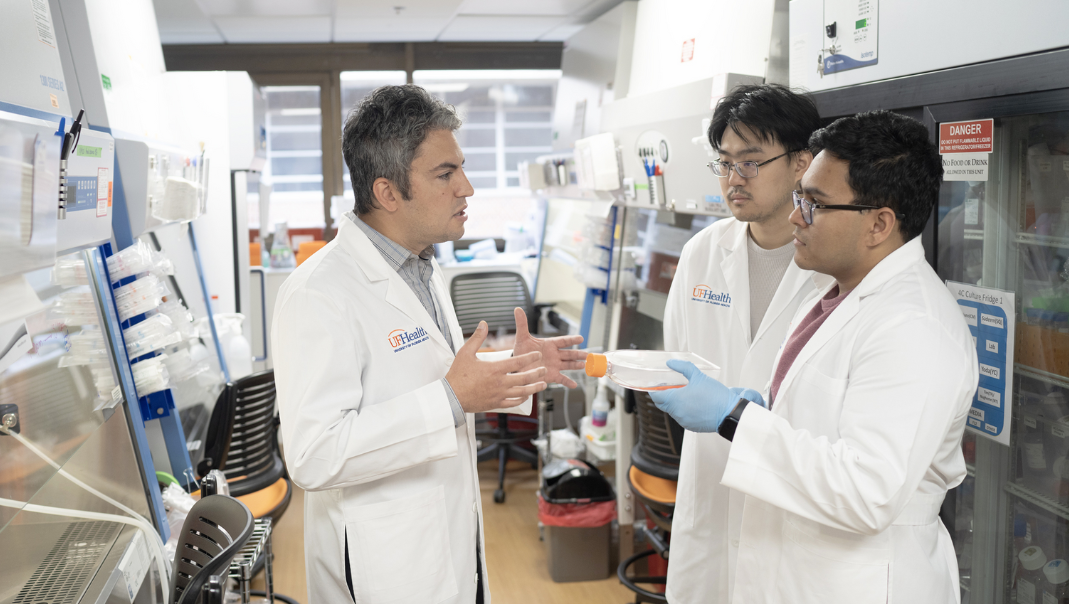Turning Up the Heat on Tumors – ICBR Supports Landmark Study in Novel Cancer Vaccine Strategy
Turning Up the Heat on Tumors – ICBR Supports Landmark Study in Novel Cancer Vaccine Strategy
The ICBR Cytometry and Electron Microscopy Shared Resources played an integral part in supporting a landmark study from UF cancer researchers published in the May 1 issue of the prestigious journal Cell. The study, led by physician scientist Dr. Elias Sayour, a UF Health pediatric oncologist and co-leader of the UF Health Cancer Center’s Immuno-Oncology and Microbiome research program, represents a potential new way to recruit the immune system to fight treatment-resistant cancers using an iteration of mRNA technology and lipid nanoparticles. The approach is similar to the RNA particle-based COVID-19 vaccines except for two key differences. First, the patient’s own tumor cells are used to create a “personalized” vaccine, and second, the novel engineered nanoparticle complex comprises the delivery mechanism within the vaccine. The Sayour study was supported by ICBR experts Dr. Andria Doty and Dr. Patrick Kellish in the Cytometry Shared Resource. In addition, Scientific Director Paul Chipman and his staff in the ICBR the Electron Microscopy Shared Resource provided imaging data critical for understanding the novel nanoparticle vaccine structure.

(From left) Sadeem Qdaisat, Dr. Hector Mendez-Gomez and Dr. Elias Sayour discuss their new study.
The work focuses on a new treatment for glioblastoma, amongst the most devastating diagnoses, with median survival around 15 months, and exemplifies the UF Health Cancer Center’s multidisciplinary approach to cancer research, which includes collaborating with veterinary oncology researchers on clinical studies using pet dogs. Dogs offer a naturally occurring model for malignant glioma because they are the only other species that develops spontaneous brain tumors with some frequency. The 10 pet dogs treated in the study with the novel vaccine lived a median of 139 days, compared with a median survival of 30 to 60 days typical for dogs with no treatment.
Using the findings from the vaccine’s efficacy in dogs, Sayour’s team advanced the research to a small FDA-approved human clinical trial designed to ensure safety and test feasibility before expanding to a larger trial. In a cohort of four patients, protein-coding mRNA was extracted from each patient’s own surgically removed tumor, amplified and wrapped in the newly designed high-tech packaging of biocompatible lipid nanoparticles. The tumor-derived mRNAs are taken up by special immune system cells, translated into tumor-specific proteins and displayed on the surface of immune cells. This process programs the immune system to recognize any cells with these same tumor proteins as foreign and prompts an immune-system response. The original tumor cells are recognized by the immune system as foreign invaders and are subsequently attacked and killed. The vaccine was personalized to each patient with a goal of getting the most out of their unique immune system.
“Instead of us injecting single particles, we’re injecting clusters of particles that are wrapping around each other like onions, like a bag full of onions,” said Dr. Sayour, “And the reason we’ve done that in the context of cancer is these clusters alert the immune system in a much more profound way than single particles would.”
Perhaps the most impactful finding of Dr. Sayour’s study is how quickly the new vaccine, which was delivered intravenously, fueled a vigorous immune-system response to reject the tumor.
“In less than 48 hours, we could see these tumors shifting from what we refer to as ‘cold’ — immune cold, very few immune cells, very silenced immune response — to ‘hot,’ very active immune response,” he said. “That was very surprising given how quick this happened, and what that told us is we were able to activate the early part of the immune system very rapidly against these cancers, and that’s critical to unlock the later effects of the immune response.”
The next step, through support from the Food and Drug Administration and the CureSearch for Children’s Cancer foundation, will be an expanded Phase I clinical trial to include up to 24 adult and pediatric patients to validate the findings. Once an optimal and safe dose is confirmed, an estimated 25 children would participate in Phase 2 trials.
“This work would not have been possible without the amazing infrastructure and technical expertise of the cryoEM and Cytometry core at the UF ICBR,” said Sayour, “I am hopeful for how this could now synergize with other immunotherapies and perhaps unlock those immunotherapies. We showed in this paper that you actually can have synergy with other types of immunotherapies, so maybe now we can have a combination approach of immunotherapy.”
(This article is a condensed version of a story appearing in UF Cancer Research News, May 1, 2024, and includes details on the significant contributions from ICBR. For the full article, please visit UF Cancer Research News.)


